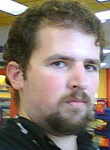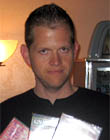|
|
 
|
|
Author
|
Topic: 20 year olds asks: "What's a Drive-In?"
|
John Wilson
Film God

Posts: 5438
From: Sydney, Australia.
Registered: Dec 1999
|
 posted 05-05-2008 09:13 PM
posted 05-05-2008 09:13 PM




Link to story
A Trip Down Memory Lane Through Drive-In Theaters
By Eugene Scheel
Sunday, May 4, 2008; Page PW15
While getting a haircut in downtown Leesburg, I asked my barber, Sidney Smith, if he had ever been to a drive-in. Many times as a youngster with his family in the 1960s, he told me. Overhearing us, a customer in his 20s asked: "What's a drive-in?"
The conversation occurred because I was trying to find the name of a long-gone drive-in movie theater in Culpeper County so I could put it on a historical map. Someone finally referred me to Joe Quaintance, who had built the theater.
As Quaintance and I talked, I realized that this man could be considered the 1950s drive-in king of the mid-Atlantic and Northeast. Now 85, he put together the guts of more than 30 of the theaters -- trenching, electrical wiring and speakers -- and often filled in as a projectionist.
When I visited him recently at the home he constructed for his family in 1960 near Culpeper, he greeted me with a map of Virginia and Maryland and showed me, with a highlighter, the locations of 18 drive-ins he built in those two states. He estimates he worked on another 15 in Delaware, Pennsylvania, New Jersey and New York.
The Virginia projects stretched from the North Carolina line to the Potomac River and included four theaters in the Virginia Piedmont -- in Manassas, Warrenton, Culpeper and Orange. Among the Maryland locations were theaters in Baltimore, Annapolis and Prince George's County.
Benjamin Thomas Pitts, the movie mogul of Northern Virginia, paid Quaintance to activate nine of the Virginia theaters, as well as a West Virginia drive-in near Harpers Ferry.
In the late 1920s and 1930s, Pitts had launched or remodeled the indoor movie theaters in Fredericksburg, Orange, Culpeper, Warrenton and Leesburg. Many addressed him as Senator Pitts, for he represented the Fredericksburg area in the state Senate from 1944 to 1958. Quaintance, a close friend who did not live in his district, called him Mr. Pitts.
In the late 1940s, when gasoline rationing had ended and the typical Piedmont family could afford an automobile or pickup, Pitts picked the region as a place to try to cash in on the new drive-in movie craze, which was sweeping through much of rural and small-town America.
Going to the drive-in was "like a weekend outing, a family picnic," said Smith, who remembers the theater near Harpers Ferry quite well. "You walked around, visiting friends, going to the snack bar. You knew you were somebody if you saw your friends at a drive-in. If you didn't have a lot of money, you could fix a little picnic basket and have drinks and ice in the cooler. You took that speaker and put it down on the blanket."
Piedmont bankers weren't so sure about this new fad. So Pitts asked Culpeper's mayor and well-known investor, T.I. Martin, if he could help finance several of the theater projects. Martin did, and around 1948 he asked Quaintance "if I would do the electrical work in a drive-in they were building," Quaintance recalled.
Quaintance had grown up in Culpeper and had wired houses since 1938, when he was 15. He figures that the 2 1/2 years he spent in the Navy were worth "five years of education" in electronics and radar. "Went to school seven days a week, 12 hours a day," he said.
Electrical wiring was the make-it-or-break-it of a drive-in, Quaintance said.
Smith, the barber, agrees. "The worst thing that could happen was to get there early, choose your space, and then find out that the speaker wasn't working," he said. "You'd have to move."
Manassas got the first of the four Virginia Piedmont drive-ins, with 250 spaces for vehicles. "It was the biggest because it was closest to Washington, out Route 28 just west of town. The rest were for 200 vehicles," Quaintance said. Warrenton's was next, on Bear Wallow Road near old U.S. 17. Culpeper's drive-in was on Bradford Road close to old U.S. 29-211. Orange's was just south of town on U.S. 15.
Quaintance and his crew of three or four built them all in a year and a half, he told me. They were relatively easy jobs. "None of the Virginia [Piedmont] drive-ins were paved. You trenched down 15 inches and put in the wires," he said. "Pitts used the best eight-inch speakers -- good sound. The only lights were on a wooden pole next to the snack stand."
The snack stand was always cinderblock; it housed the camera and sound system and two restrooms.
"They first charged a dollar a car or pickup, but after a few years it went to $1.50 a person, kids free," Quaintance said.
Smith told me that the new fees didn't sit well with some. "Once things quieted down, you'd see car trunks popping open and people popping out of the trunk," he said.
Quaintance told me that the feature films shown at drive-ins were always black-and-white in the 1940s and '50s. The first show began at dusk, around 7 or 7:30, the second about 9:30. Daylight Saving Time had not arrived. A vehicle could stay for both shows, but families with children left after the first feature.
Pitts could never crack Loudoun County. The spreads around Leesburg were large, and farmers wanted too much money for the land, more than $1,000 an acre, even in the late 1940s. To make money, Pitts needed land he could buy for less than $500 an acre or lease reasonably. Virginia drive-ins, unlike those in the North, didn't have heaters and were closed from Thanksgiving to April. On rainy nights, the cars were few.
A drive-in also needed at least 10 acres so the lights wouldn't bother neighbors too much and so the three- to five-acre theater area would be buffered to discourage "hilltopping" -- people off the property watching the show.
None of the counties Pitts picked for his investments had zoning, and Quaintance didn't have to worry about electrical inspections. There were none. He checked the wiring of each theater every few months, "but I never saw a movie. Most of the time I was too tired to stay up to watch them. I still don't watch them on TV."
I asked Quaintance if any of the drive-ins he built were segregated. "Only Emporia [near the North Carolina line]. There was a fence separating the black from the white section."
Quaintance's wiring talents led him north to far larger drive-ins in the 1960s. "All those states made me take an exam. Maryland even said I didn't have the qualifications to take the exam, but Old Man Ward ran interference," he said, using an old expression for a well-connected politician. "I got a 96 on the test."
Some drive-ins, such as the one in Warrenton, stayed open for 30 years. Others lasted until the 1990s. Television was a factor in their demise, but it was the mushrooming price of land near towns that induced Pitts's organization to sell for a tidy profit.
Quaintance withdrew from 42 years of wiring drive-ins in 1980, but well before that he prepared for retirement by buying property. He also owns and manages two water systems serving about 100 homes on the outskirts of Culpeper.
One nearby vestige of the cinematic past survives: Family Drive In, one mile south of Stephens City, on U.S. 11 in Frederick County, Va. For show times, call 540-665-6982 or visit http://www.user.shentel.net/ccrkcr/drivein.html.
* * *
Eugene Scheel is a historian and mapmaker who lives in Waterford.
| IP: Logged
|
|
|
|
|
|
|
|
|
|
|
|
|
|
|
|
All times are Central (GMT -6:00)
|
|
Powered by Infopop Corporation
UBB.classicTM
6.3.1.2
The Film-Tech Forums are designed for various members related to the cinema industry to express their opinions, viewpoints and testimonials on various products, services and events based upon speculation, personal knowledge and factual information through use, therefore all views represented here allow no liability upon the publishers of this web site and the owners of said views assume no liability for any ill will resulting from these postings. The posts made here are for educational as well as entertainment purposes and as such anyone viewing this portion of the website must accept these views as statements of the author of that opinion
and agrees to release the authors from any and all liability.
|

 Home
Home
 Products
Products
 Store
Store
 Forum
Forum
 Warehouse
Warehouse
 Contact Us
Contact Us




 Printer-friendly view of this topic
Printer-friendly view of this topic










![[Razz]](tongue.gif)



